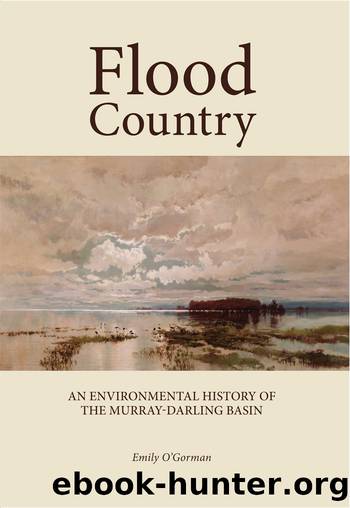Flood Country by Emily O'Gorman

Author:Emily O'Gorman [O'Gorman, Emily]
Language: eng
Format: epub
Tags: Nature, General
ISBN: 9780643101586
Google: HBf-Cnabc90C
Publisher: Csiro Publishing
Published: 2012-01-15T16:02:53+00:00
The RMC: engineering and the Murray River watershed
Historian Don Wright has noted that â[t]he paradox of the Murray ⦠was that it did not only divide. It also unitedâ.63
Although a political boundary and source of dispute between NSW, Victoria, and South Australia, the Murray often united those who lived along its banks.64 The drought that had crippled the pastoral industry along the Darling also severely affected farmers along the Murrumbidgee and Murray. Towards the end of 1901 the drought intensified, prompting farmers to take matters into their own hands. Small lobby groups emerged along the Murray and Murrumbidgee, campaigning for engineering works to ensure steady water supply to their drought-stricken properties. The smaller groups soon united into the pro-irrigation River Murray Canal League.65
To lobby decision-makers directly, the League organised a conference to which it invited parliamentary representatives from districts in NSW and Victoria as well as state premiers and the Prime Minister. At the conference, held in Cowra in April 1902, the League delegates, mostly farmers, called for action to ensure a stable water supply for both navigation and irrigation, and for the states to overcome their differences.66 The conference resulted in the governments of NSW, Victoria and South Australia establishing an interstate commission to investigate possibilities for water storages, irrigation, and improved navigation on the Murray.
The commission consisted of representatives from the three states. Despite the potential for the commission to implode through disagreements between the state commissioners, it finally established the primacy of irrigation over navigation. There was neither enough trade nor water to warrant the predominance of navigation. Although the needs of irrigation would be put first, the commission also recommended navigation locks be constructed along the Murray.67
Wright noted that another important and lasting resolution of the commission regarding the Murray was that âthe whole river system must be treated as a unit under the joint management of the three Statesâ.68 However, the subsequent River Murray Waters Agreement and RMC rather consolidated a watershed administration around the Murray, creating a political and administrative gulf between the Murray and Darling systems and dividing the basin rather than uniting it. Significantly, the upper Darling and its tributaries remained outside interstate policies. This was partly because when the governments of NSW, Victoria, and South Australia signed the River Murray Waters Agreement in 1915 and two years later formed the RMC, Queensland and the upper tributaries of the Darling were not included. Queensland had little development on, or future plans for, the Darling tributaries within its boundaries, and its involvement seemed negligible to the other states. Further, NSW government reports had strongly advised against putting money towards expensive and fruitless irrigation projects and improved navigation on the erratic Darling River. The upper Darling and its tributaries were treated merely as inconsequential Murray feeders, thrown into the shadows by the intense focus on the Murray itself.
In some ways the focus of the RMC on the Murray River was also a recognition of the hydrological differences between the snow-fed Murray and the more variable Darling river systems.
Download
This site does not store any files on its server. We only index and link to content provided by other sites. Please contact the content providers to delete copyright contents if any and email us, we'll remove relevant links or contents immediately.
| Automotive | Engineering |
| Transportation |
Whiskies Galore by Ian Buxton(41525)
Introduction to Aircraft Design (Cambridge Aerospace Series) by John P. Fielding(32885)
Small Unmanned Fixed-wing Aircraft Design by Andrew J. Keane Andras Sobester James P. Scanlan & András Sóbester & James P. Scanlan(32570)
Craft Beer for the Homebrewer by Michael Agnew(17930)
Turbulence by E. J. Noyes(7696)
The Complete Stick Figure Physics Tutorials by Allen Sarah(7135)
Kaplan MCAT General Chemistry Review by Kaplan(6591)
The Thirst by Nesbo Jo(6432)
Bad Blood by John Carreyrou(6271)
Modelling of Convective Heat and Mass Transfer in Rotating Flows by Igor V. Shevchuk(6219)
Learning SQL by Alan Beaulieu(6031)
Weapons of Math Destruction by Cathy O'Neil(5825)
Man-made Catastrophes and Risk Information Concealment by Dmitry Chernov & Didier Sornette(5644)
Digital Minimalism by Cal Newport;(5388)
Life 3.0: Being Human in the Age of Artificial Intelligence by Tegmark Max(5182)
iGen by Jean M. Twenge(5158)
Secrets of Antigravity Propulsion: Tesla, UFOs, and Classified Aerospace Technology by Ph.D. Paul A. Laviolette(4984)
Design of Trajectory Optimization Approach for Space Maneuver Vehicle Skip Entry Problems by Runqi Chai & Al Savvaris & Antonios Tsourdos & Senchun Chai(4837)
Electronic Devices & Circuits by Jacob Millman & Christos C. Halkias(4744)
